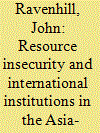| Srl | Item |
| 1 |
ID:
170996


|
|
|
|
|
| Summary/Abstract |
As the Belt and Road Initiative expands the global footprint of Chinese firms, Beijing increasingly relies on international law to protect investments overseas. How and why has China's engagement with the international investment regime evolved over the past four decades? This article addresses these questions by examining the central component of the international investment regime: bilateral investment treaties (BITs). Through analyzing China's BIT practice and the security exceptions in 1,173 BITs concluded by both China as well as its treaty partners, this article provides evidence of changing Chinese engagement, from cautious interaction (1978–1991) to active participation (1992–1997), committed implementation (1998–2012), and mature influence (2013–present). As Beijing accepted, applied, and shaped the rules and norms of the BIT system, China's treaty practice co-evolved with the international investment regime. A co-evolutionary approach illuminates why—and how—state behaviour and international orders change over time.
|
|
|
|
|
|
|
|
|
|
|
|
|
|
|
|
| 2 |
ID:
120204


|
|
|
|
|
| Publication |
2013.
|
| Summary/Abstract |
East Asian governments have long recognized that national security must incorporate a reduction of their vulnerability to the disruption of essential imports. The rapid economic growth of China and India has intensified competition for increasingly scarce resources, elevating resource security once again to the top of the international agenda. Issues that were previously regarded as 'technical' have been 'securitized' as state elites perceived possible conflicts over availability and pricing of natural resources as threats to national security.
International institutions have the potential to contribute to the defusing of tensions over the supply of commodities by providing, through various means, assurances regarding the behaviour of partners. Only the global institutions concerned with commodities trade, the International Energy Agency (IEA) and the World Trade Organization (WTO), have legally binding arrangements and the authority to impose sanctions on states that fail to comply with their obligations. But both have weaknesses: the IEA's membership is limited; the WTO's rules relating to raw materials trade are far from comprehensive. Most of the regional institutions in this field seldom go beyond information exchange or the setting of aspirational targets. At the bilateral level, government attempts to enhance resource security through minerals chapters in preferential trade agreements have had little success. Bilateral investment treaties are the only instances of cooperation at the sub-global level that incorporate legally-binding provisions.
The cooperation on resources issues in which countries have engaged has reflected the core characteristics of Asia-Pacific bilateral and regional intergovernmental institutions. The shallowness of cooperation reflects perceptions on the part of state elites that their interests in the resources sector are best served by national rather than collective action and that current cooperative arrangements fail to provide sufficient incentives to prevent states from succumbing to opportunistic behaviour in the event of a short-term clash of interests. The potential gains to be made from a cooperative approach to resource security remain largely unrealized.
|
|
|
|
|
|
|
|
|
|
|
|
|
|
|
|
| 3 |
ID:
143775


|
|
|
|
|
| Summary/Abstract |
This article explores the domestic and international factors that influence the strength of investment protection and liberalization provisions embedded in China’s bilateral investment treaties (BITs). It hypothesizes that China is more likely to sign stringent BITs following the leadership’s implementation of major reform initiatives; when the partner country possesses strong democratic institutions that not only allow domestic interest groups with strong interests in legalization to press for their policy preferences, but also reduce the leaders’ aversion to signing highly legalistic international agreements that bind their behavior; when divergent diplomatic interests render informal negotiations a less viable means of dispute resolution. Statistical analyses of the stringency of the key provisions included in 71 Chinese BITs signed between 1982 and 2011 lend substantial support to the above hypotheses.
|
|
|
|
|
|
|
|
|
|
|
|
|
|
|
|